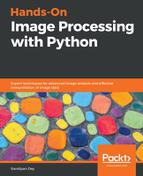Let's now compute the HOG descriptors using the scikit-image feature module's hog() function and visualize them:
from skimage.feature import hog
from skimage import exposure
image = rgb2gray(imread('../images/cameraman.jpg'))
fd, hog_image = hog(image, orientations=8, pixels_per_cell=(16, 16), cells_per_block=(1, 1), visualize=True)
print(image.shape, len(fd))
# ((256L, 256L), 2048)
fig, (axes1, axes2) = pylab.subplots(1, 2, figsize=(15, 10), sharex=True, sharey=True)
axes1.axis('off'), axes1.imshow(image, cmap=pylab.cm.gray), axes1.set_title('Input image')
Let's now rescale the histogram for a better display:
hog_image_rescaled = exposure.rescale_intensity(hog_image, in_range=(0, 10))
axes2.axis('off'), axes2.imshow(hog_image_rescaled, cmap=pylab.cm.gray), axes2.set_title('Histogram of Oriented Gradients')
pylab.show()
Here's the output that you should get—notice the visualization of the HOG features computed:

In Chapter 9, Classical Machine Learning Methods in Image Processing, we will discuss how to use the HOG descriptors to detect objects from an image.
